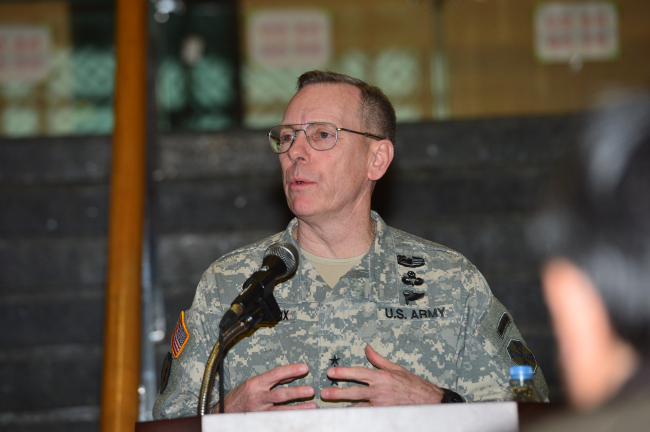With delays in the expansion project of the U.S. military base in Pyeongtaek, Gyeonggi Province, the relocation of the bulk of troops from central Seoul and other northern regions due to conclude in 2016 will take another year, the commander of the 8th U.S. Army said Thursday.
Under the plan, initially slated to take place in 2008 but delayed until 2012, Camp Humphreys will be home to some 42,000 U.S. forces and their families as they shift in stages, said Lt. Gen. Bernard Champoux, who is also the commanding general of the 8th U.S. Army and chief of staff of the Combined Forces Command. Currently, about 86 percent of construction has been completed.
 |
|
Lt. Gen. Bernard Champoux, commander of the 8th U.S. Army. (Yonhap) |
Kim Kie-soo, director of the U.S. Forces Korea base realignment at Seoul’s Defense Ministry, said the timeline change was inevitable given the sheer scale of transfer, the bankruptcy of a contractor and ensuing rebidding process and a change in U.S. immigration policy that affected military families.
“If the work progresses at the current pace, we’re expecting that the construction will largely end and the relocation will begin in earnest next year and finish by 2017,” Kim told reporters during a tour of the Pyeongtaek base, some 35 kilometers south of the capital.
“The realignment will offer a chance for South Korea to use its territory more effectively, and make possible the USFK’s more stable stationing and better peninsula protection.”
Despite lingering worries over the alliance’s possible weakening of its capabilities to counter North Korean threats, the relocation will rather improve its response to any contingency and defense of the peninsula, Champoux said, vowing constant “Fight Tonight” combat readiness.
The proximity to Osan Air Base and Pyeongtaek port and railways will allow troops, reinforcements and supplies to mobilize quickly, he noted.
In addition, the CFC will remain in a downsized Yongsan Garrison until Seoul hands over its wartime operational control to Washington, as well as the 210 Fire Brigade, a U.S. key counterfire unit, north of Seoul until South Korea’s artillery reinforcement is ready. Albeit not permanently, this could send a strong signal to Pyongyang, analysts have said.
The decision was made between the two nations’ defense ministers during the annual Security Consultative Meeting in Washington in October 2014.
“Our forces north of the Hangang (River) have them, and we will have them here,” the commander said, noting that Patriot missile-defense batteries will be deployed at Osan.
“We are constructing hundreds of new buildings and adding 2,000 acres (809 hectares) to this installation,” he added, calling the project an “enormous, complicated plan.”
By Shin Hyon-hee (heeshin@heraldcorp.com)

